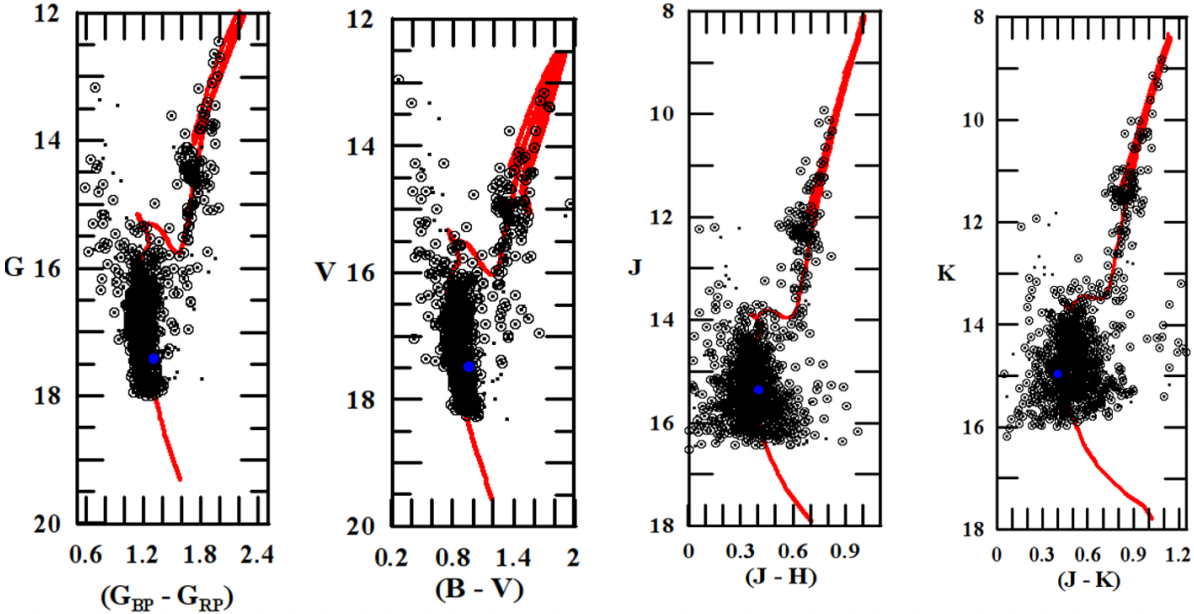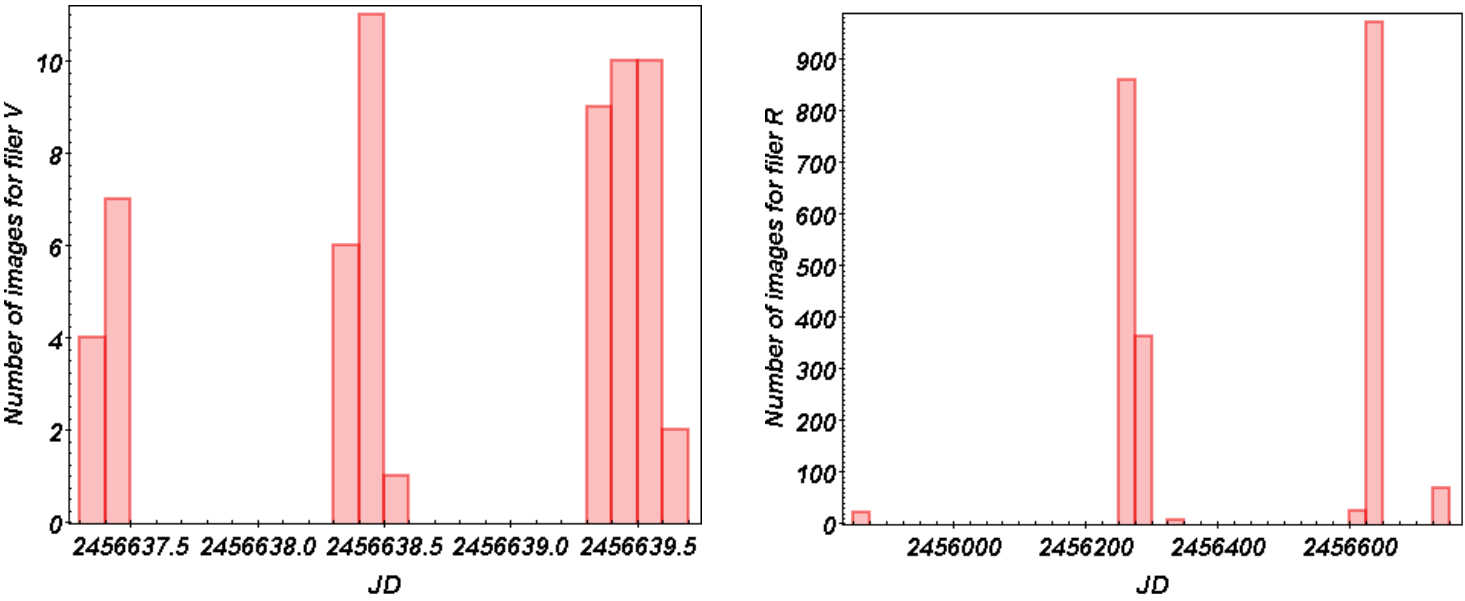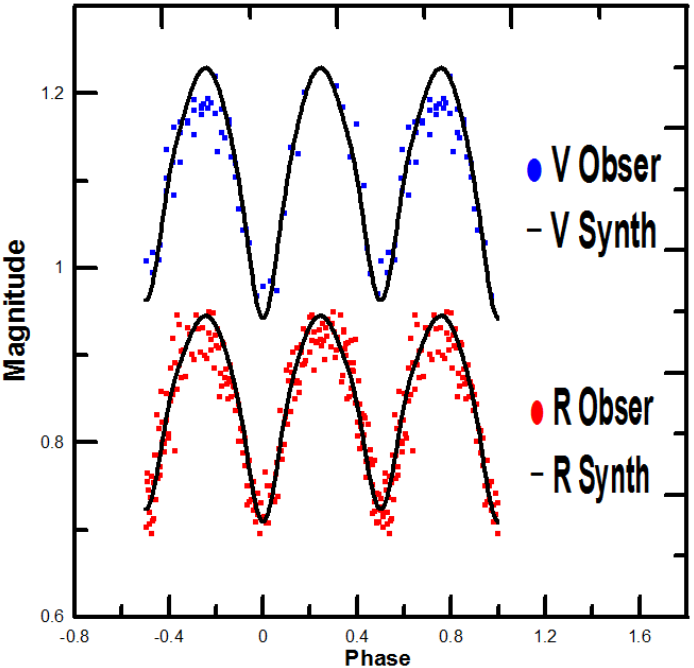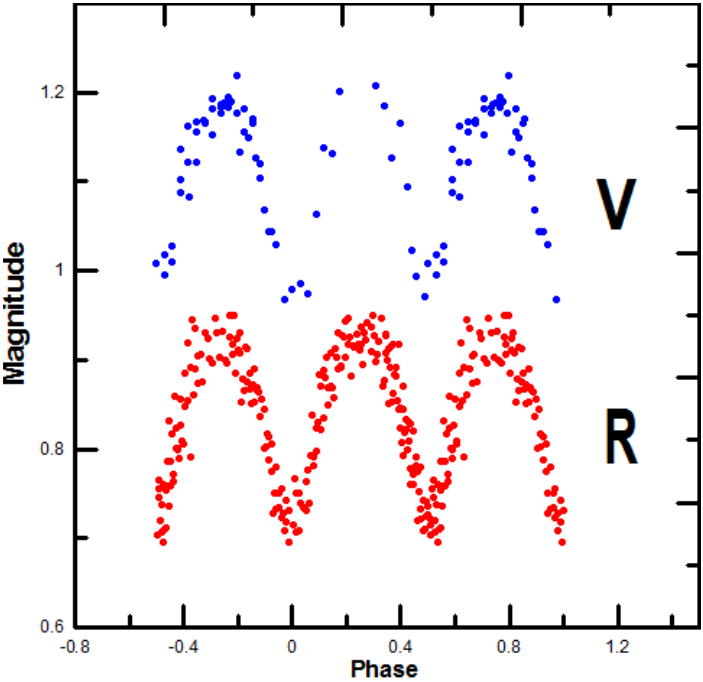1. INTRODUCTION
Photometric studies of open clusters in the optical and infrared are fundamental
tools for determining their structural parameters. These parameters play an
important role towards understanding galactic structure and evolution. NGC 2158
[Melotte 40] is a rich northern open cluster of intermediate age, located in the
constellation Gemini (Carraro et al. 2002). It
has a diameter of about 50 (Lynga et al.
1987). Anderson et al. (2013)
estimated a core radius Rcor = 10.7 and a limiting radius Rlim = 180.60. Bedin et al. (2010) estimated log(age)=9.301,
E(B−V ) = 0.420mag, (

Fig. 1 Color image of the open cluster NGC 2158 from the Pan-STARRS survey (Panoramic Survey Telescope and Rapid Response System). The size of the field of view is 21' × 21'. The large red circle marks the region of the open cluster NGC 2158, while the small red circle gives the position of the eclipsing binary [NBN2015]78. The color figure can be viewed online.
Studying eclipsing binary systems in the field and clusters gives valuable information about the physical and absolute parameters of the stars, such as masses and radii. Eclipsing binaries of the W UMa type are very important objects to study the evolutionary state of close binary stars and to characterize their formation. When they are members of a stellar cluster, the distance, age and metallicity of these stars are known independently, which makes them an ideal test for theories of binary structure and evolution. [NBN2015]78 is a poorly studied early-type eclipsing binary star which is located in the field of the open cluster NGC 2158. The designation comes from Nardiello et al. (2015), as it is the number 78 in their catalogue. It is also known as NGC 2158 MSS V60, NGC 2168 HIZ V6, and 2MASS J06073800 +2407249. It is a short period (0.341325 days) eclipsing binary system (Nardiello et al. 2015).
The main aim of this work is to present the photometric and astrometric parameters for the open cluster NGC 2158 and to perform a light curve analysis and modelling of the eclipsing binary [NBN2015]78. This paper is organized as follows: the photometric and astrometric study of the open cluster NGC 2158 is presented in § 2. The photometric study of the eclipsing binary [NBN2015]78 is presented in § 3. Finally, discussions and conclusions are summarized in § 4.
2. Photometric and astrometric study of the open cluster NGC 2158
2.1. Data and Analysis
In the present work, we use both the GAIA DR2 and 2MASS databases. Astrometric, photometric and spectroscopic measurements of the entire sky have been obtained by the ESA mission Gaia (Gaia Collaboration et al. 2016). The latest version of the Gaia data (Gaia DR2) contains over 1.3 billion sources in three photometric bands (G,GBP,GRP), in addition to their proper motion and parallax (Gaia Collaboration et al. 2018, Lindegren et al. 2018). The limiting G-band magnitude of Gaia DR2 data is 21 mag. At the bright end (G < 14mag), the uncertainties reach 0.02 mas in parallax and 0.05 mas/yr in proper motions, while for sources near G ∼ 21 mag the uncertainties reach 2 mas and 5 mas/yr respectively. The 2MASS survey is the catalog of choice for astronomical studies near the Galactic plane (Skrutskie et al. 2006). The limiting magnitudes of 2MASS data J(1.25 µm), H(1.65 µm) and K(2.17µm) are 15.8, 15.1 and 14.3 mag, respectively.
We extracted the data around NGC 2158 inserting the coordinates of the cluster
NGC 2158 as RA=06h 07m 25s.00, DEC=+24
To obtain the best astrometric precision of the proper motions, we used the
sources brighter than G = 18 mag, which correspond to typical astrometric
uncertainties smaller than 0.3 mas/yr in proper motion (Cantat-Gaudin et al. 2018, Lindegren et al. 2018). Using the Vector Point Diagram (VPD) of the
proper motions in RA and DEC, we select the overdensity in the cluster region,
obtaining 2103 stars (red region on the left panel, Figure 2). To obtain the candidate cluster members, we
removed stars from the selected cluster region (red region) if their proper
motions in RA and DEC were inconsistent with a median proper motion by more than
three median absolute deviations (MAD). The color magnitude diagram (CMD) in the
right panel of Figure 2 shows that the
candidate members (red dots) fall on a well-defined main sequence. The selected
cluster region of the candidate members has a nearly ellipsoidal shape. The
equivalent radius

Fig. 2 The left panel shows the Vector Point Diagram (VPD), and the right panel shows the Color Magnitude Diagram (CMD) of the open cluster NGC 2158. The selected red region from the VPD marks the candidate member stars. The blue triangle and the black dots represent the eclipsing binary [NBN2015]78 and the field stars respectively. The red dots on the CMD represent candidate members. The color figure can be viewed online.
Our membership criterion depends on the chosen overdensity region to define the members of the cluster from the VPD, which obviously is a compromise between losing cluster members and including field stars (see Bisht et al. 2019). To minimize the field contamination, we used the Blob subset from TOPCAT for selecting the cluster region in the VPD.
Stars are considered members if they lie inside the overdensity cluster region in VPD and have proper motions in RA and DEC within ±3 MAD from the mean proper motion; they must also have a clear main sequence in the CMD (Figure 2). These stars must be inside the limiting radius and they should have the same direction of proper motion vectors (Figure 4). The cluster members must have the same angular speed in the space.
To determine the mean proper motion of the cluster, we constructed the histograms and made a Gaussian fitting of the proper motions in both directions RA and DEC, see Figure 3. We found that the mean proper motion of NGC 2158 is pmRA =−0.159 ± 0.165mas/yr and pmDEC = −2.000 ± 0.175mas/yr. These values are in good agreement with the values obtained by Cantat-Gaudin et al. (2018), see Table 1.

Fig. 3 The histograms of the proper motion in RA (mas/yr) and DEC (mas/yr), and the Gaussian fits are shown as blue dashed lines. The color figure can be viewed online.
TABLE 1 ESTIMATION OF THE pmRA AND THE pmDEC VALUES OF THE OPEN CLUSTER NGC 2158
| Parameter | Values | References |
|---|---|---|
| pm |
|
Present study |
|
|
Cantat-Gaudin et al. (2018) | |
|
|
Loktin and Popova (2017) | |
|
|
Kharchenko et al. (2013) | |
|
|
Wu et al. (2009) | |
|
|
Dias et al. (2002) | |
| pm |
|
Present study |
|
|
Cantat-Gaudin et al. (2018) | |
|
|
Loktin and Popova (2017) | |
|
|
Kharchenko et al. (2013) | |
|
|
Wu et al. (2009) | |
|
|
Dias et al. (2002) |
The measured proper motions of the eclipsing binary [NBN2015]78 in Gaia DR2 are pmRA=−3.252 ± 0.673mas/yr and pmDEC =−2.63 ± 0.596mas/yr with relative uncertainties smaller than 20%. The position of the eclipsing binary [NBN2015]78 in VPD is found to be very far away from the cluster region, close to the main sequence of the CMD (Figure 2). It is clearly seen that the direction of the proper motion vector of [NBN2015]78 in Figure 4 is different from the direction of the cluster members. Therefore, in spite of its position in the color magnitude diagrams in the optical and IR (2MASS, Figure 7) this eclipsing binary does not seem to be a member of the cluster.
2.2. Cluster Center and Radius
To determine the cluster center we count the stars in right ascension (RA) and
declination (DEC). The center of the open cluster NGC 2158 is calculated at the
point where the maximum stellar density of the cluster’s area is reached, using
a Gaussian fitting. The center of the cluster NGC 2158 is found to be at RA =
91°.866±0°.077 and DEC = 24°.109±0°.070, and the corresponduing Galactic
coordinates are

Fig. 5 Inferring the center of NGC 2158 in RA (left panel) and DEC (right panel). The blue lines are Gaussian fits. The color figure can be viewed online.
TABLE 2 ESTIMATIONS OF THE CENTER OF THE OPEN CLUSTER NGC 2158
| Parameter | Values | References |
|---|---|---|
| RA (deg) | 91.866 ±0.077 | Present study |
| RA (hh:mm:ss) | 06:07:27.84 | Present study |
| 06:07:26.88 | Cantat-Gaudin et al. (2018) | |
| 06:07:26.40 | Loktin and Popova (2017) | |
| 06:07:25.68 | Kharchenko et al. (2013) | |
| 06:07:25.00 | Anderson et al. (2013), Wu et al. (2009) Dias et al. (2002) | |
| DEC (deg) | 24.109 ±0.070 | Present study |
| DEC (dd:mm:ss) | 24:06:32.40 | Present study |
| 24:05:56.40 | Cantat-Gaudin et al. (2018) | |
| 24:05:52.80 | Loktin and Popova (2017) | |
| 24:05:31.20 | Kharchenko et al. (2013) | |
| 24:05:48.00 | Anderson et al. (2013), Wu et al. (2009) Dias et al. (2002) | |
|
|
186.629 | Present study |
| 186.635 | Cantat-Gaudin et al. (2018) | |
| 186.704 | Loktin and Popova (2017) | |
| 186.635 | Kharchenko et al. (2013) | |
| 186.634 | Anderson et al. (2013), Wu et al. (2009) Dias et al. (2002) | |
| b (deg) | 1.796 | Present study |
| 1.788 | Cantat-Gaudin et al. (2018) | |
| 1.786 | Loktin and Popova (2017) | |
| 1.774 | Kharchenko et al. (2013) | |
| 1.781 | Anderson et al. (2013), Wu et al. (2009) Dias et al. (2002) |
To calculate the core and limiting radii, we measure the radial density profile (RDP) of the open cluster NGC 2158, extracting the brightest stars G ≤ 18 mag within a square region of side 2 mas/yr around the center of the overdensity in the VPD, see Figure 2. We then divide the square area around the cluster into concentric rings. The stars are counted within each ring and their number divided by the area of each ring. A King (1966) model is then fitted to the radial density profile of NGC 2158 as shown in Figure 6.
where fbg, f0 and Rcore are the background density, the central star density and the core radius of the cluster, respectively. The bestfit values are f0 = 67.06 ± 2.47 stars/arcmin2 and Rcore = 1'.70 ± 00.08 see Table 3. The limiting radius of NGC 2158 is estimated as Rlim = 17'.00, beyond which stars begin to merge with the background population (see Figure 6, Tadross and Hendy 2016; Hendy 2018). Following Peterson and King (1975), we find that the concentration parameter C = logs(Rlim/Rcor) of NGC 2158 is C = 1.00.

Fig. 6 The radial density profile of NGC 2158. The red curved line is our best-fit King profile). The value of the limiting radius is Rlim = 17'.00. The solid line represents the background density. The color figure can be viewed online.
TABLE 3 THE RDP PARAMETERS OF THE OPEN CLUSTER NGC 2158
| Parameter | Values | Reference |
|---|---|---|
|
|
17.00 | Present study |
| 15.00 | Kharchenko et al. (2013) | |
| 18.60 | Anderson et al. (2013) | |
| 07.50 | Glushkova et al. (2010) | |
|
|
01.70 ±0.08 | Present study |
| 02.40 | Kharchenko et al. (2013) | |
| 01.71 | Anderson et al. (2013) | |
| Concentration parameter ( |
01.00 | Present study |
|
|
67.06 ±2.47 | Present study |
Our estimations of the core and limiting radii are in very good agreement with the ones obtained by Anderson et al. (2013) and Kharchenko et al. (2013), see Table 3, but the limiting radius obtained by Glushkova et al. (2010) is significantly smaller than the one we find.
2.3. Color Magnitude Diagrams
To obtain photometric data for multi-color magnitude diagrams (MCMDs), we cross-matched our cluster members in Figure 4 with Gaia, 2MASS and BV data from Nardiello et al. (2015). We obtained 1223 common stars which are members of the cluster. The MCMDs of NGC 2158 are built using optical data from Gaia DR2 [G,(GBP −GRP)], Nardiello et al. (2015) [V,(B − V )] and infrared 2MASS data [J,(J − H) and J−,J − K)] are shown in Figure 7.

Fig. 7 CMDs of NGC 2158: [G − (GBP − GRP)] from Gaia DR2, [V − (B − V )] from Nardiello et al. (2015) and [J − (J − H) & J − (J − K)] from 2MASS data respectively. The blue circles in the CMDs refer to the position of the eclipsing binary [NBN2015]78. The dots represent 1223 member stars in the optical (Gaia & [V − (B − V )]), and the 2MASS data using our criteria. The open circles represent 1031 membesr stars obtained by Cantat-Gaudin et al. (2018) using their UPMASK code to determine membership probabilities. The color figure can be viewed online.
To obtain the best fit for each CMD, we use the Padova isochrones of Marigo et al. (2017) with a solar metallicity of 0.0152 (Bressan et al. 2013). Using the turn-off point, we find an age of logage = 9.350 ± 0.050, that is, and age of 2.240 ± 0.260 Gyr. The extinction ratios used for correcting the magnitudes come from the following transformation equations, based on the work by Cardelli et al. (1989) and O’Donnell (1994):
and hence
Table 4 lists the comparison between the
fundamental parameters of NGC 2158 obtained here and those obtained in other
studies. Using the inferred values of the photometric color excess of NGC 2158,
we found that E(GBP − GRP) = 0.590, E(J − H) = 0.160 and
E(J − K) = 0.220. The mean color excess E(B − V ) and the intrinsic distance
modulus (m − M)0 are 0.420 ± 0.050mag and 12.540 ± 0.130mag
respectively. E(B − V ) and (m − M)0 are in a good agreement with
those estimated by Glushkova et al.
(2010), Tadross (2001); Loktin et al. (2001); Dias et al. (2002) and Bedin
et al. (2010), see Table 4.
The distance of NGC 2158 from the Sun is
TABLE 4 FUNDAMENTAL PARAMETERS OF NGC 2158
Cantat-Gaudin et al. (2018) calculated the
distance of 1229 open clusters by using the UPMASK code of probable cluster
members with probabilities larger than 50%. Lindegren et al. (2018) found that the Gaia DR2 parallaxes are
affected by a zero-point offset of −0.029 mas. Cantat-Gaudin et al. (2018) reported in their Table 1 (Vizier database reference J/A+A/618/A93) the
distance and its uncertainties d, d+ and d− as 4535.1, 3119.8 and 8301 pc
respectively4. We estimate a
distance of
The published parallax of the eclipsing binary [NBN2015]78 in Gaia DR2 is
Following Tadross (2011)we assume that the
Sun lies at distance 8.2 kpc from the Galactic center, and find, for the
following parameters: the distance of NGC 2158 from the Galactic center
3. PHOTOMETRIC STUDY OF THE ECLIPSING BINARY [NBN2015]78
3.1. Data Analysis
The photometric analysis of [NBN2015]78 was carried out using the data obtained by Nardiello et al. (2015), using the SBIG STL-11000M camera attached to the Asiago 67/92 cm Schmidt Telescope, available at the Astronomical Observatory of Padova (OAPD-Osservatorio Astronomico di Padova). The V , R data were collected from a number of images gathered over the three seasons. Table 5 presents the total number of observations in each filter as obtained from Nardiello et al. (2015) and Figure 8 shows the histogram of the observations in each filter.

Fig. 8 Histogram of the number of images collected per night during the three campaigns. The histograms refer to observations in the V and R filters. The color figure can be viewed online.
TABLE 5 LOG OF OBSERVATIONS
| Filter | # Images | Exp. time | FWHM | Median FWHM |
|---|---|---|---|---|
| (s) | (arcsec) | (arcsec) | ||
|
|
60 | 180 | 1.24-2.05 | 1.43 |
|
|
1385 | 15 | 1.35-6.34 | 2.75 |
| 27 | 120 | |||
| 2552 | 180 |
The period and the times of primary (I) and secondary (II) minima of [NBN2015]78 were obtained for the V and R filters (see Table 6). Using the method of Kwee and Woerden (1956), we infer that the new ephemeris for the system is given by
TABLE 6 TIMES OF PRIMARY AND SECONDARY MINIMA OF [NBN2015]78
| Filter | MinI | MinII |
|---|---|---|
|
|
|
|
|
|
|
|
3.2. Light Curve Analysis
The light curve analysis of the system [NBN2015]78 is performed using the light curves in both V and R bands and is carried out using the program of Wilson-Devinney (W-D, Nelson 2009; Wilson and Devinney 1971). We assumed gravity darkening and bolometric albedo exponents appropriate for the convective envelopes of late-type stars (Teff < 7500K). We adopted g1 = g2 = 0.32 (Lucy 1967) and A1 = A2 = 0.5 (Rucinski 1969). The limb-darkening coefficients were interpolated from the tables of van Hamme (1993) using the logarithmic law and the values X1 = X2 and Y1 = Y2 for the over-contact mode. The effective temperature of the primary star (T1) is adopted as 4925 K (Flower 1996), corresponding to a B−V color index of 0.959 from the combined light of both components (Nardiello et al. 2015). The adjusted parameters are the orbital inclination (i), the mean temperature of the secondary star (T2), the potential of the two components Ω = Ω1 = Ω2, the mass ratio (q), and the luminosity of the primary star (L1). We used Mode 3 in the Wilson-Devinney (W-D) program (over-contact mode not in thermal contact). The orbital solutions using both V and R light curves are performed and the accepted parameters are listed in Table 7. Figure 10 shows the best match between the model and the observed light curves. The solution shows that the primary component is the more massive and the hotter one, with a difference in effective temperature equal to 145 K. According to this solution, the two components of [NBN2015]78 are of spectral types K1 and K2 (Covey 2007).
TABLE 7 THE ORBITAL SOLUTION FOR [NBN2015]78 IN V AND R BANDS
| Parameter |
|
|
|---|---|---|
|
|
|
|
|
|
|
|
|
|
|
|
| q |
|
|
|
|
|
|
|
|
|
|
|
|
|
|
|
|
|
|
|
|
|
|
|
|
|
|
| r pole1 |
|
|
| r side1 |
|
|
| r back1 |
|
|
| r pole2 |
|
|
| r side2 |
|
|
| r back2 |
|
|
|
|
|
|
|
|
|
|

Fig. 10 V , R filters for the system [NBN2015]78 as fitted with the synthetic model (sold line). The color figure can be viewed online.
Figure 11 shows the geometric configuration
of [NBN2015]78 at different phases and the corresponding Roche lobe geometry.
The absolute physical parameters of the system are calculated using the
empirical relations of Harmanec (1988).
The mass of the primary component

Fig. 11 Geometric configuration at different phases of [NBN2015]78. The color figure can be viewed online.
3.3. Evolutionary Status of [NBN2015]78
Using the calculated physical parameters listed in Table 8 we investigated the current evolutionary status of
the system. Figure 12 shows the components
of the system in the mass-luminosity (M-L, left panel), mass-radius (M-R, middle
panel) and masstemperature (M-T, right panel) relations, along with evolutionary
tracks computed by Mowlavi et al. (2012)
for both zero age main sequence (ZAMS) and terminal age main sequence (TAMS)
with solar metallicity (

Fig. 12 The position for the components of the system on the mass-luminosity (left), mass-radius (middle) and empirical M − Teff relation (right) for intermediate mass stars. The color figure can be viewed online.
The right panel also shows the location of the components on the empirical M − Teff relation for intermediate mass stars from Malkov (2007). As it is clear from Figure 12 (left and middle panels) the primary component is lying on the ZAMS track while the secondary component is an evolved star.
4. DISCUSSION AND CONCLUSIONS
Using a combination of all the available photometric and astrometric data from the Gaia DR2 and 2MASS catalogues, we presented the optical, nearIR photometric and astrometric properties of the intermediate-age open cluster NGC 2158 and an eclipsing binary system [NBN2015]78 which is found within the same field. The main results of this study can be summarized as follows:
The cluster membership investigation was performed using a criterion based on the highprecision Gaia proper motions. We found 1223 member stars in Gaia, 2MASS and the BV catalogue of Nardiello et al. (2015), 1031of which being in the catalog of Cantat-Gaudin et al. (2018) with high membership probabilities, above > 60%.
Using multi-color magnitude diagrams (Gaia DR2, optical BV, 2MASS), we determined the age, colour excess and distance of NGC 2158 as 2.240 ± 0.260Gyr, 0.420 ± 0.050mag and 3224 ± 200pc, respectively.
Using the high-precision Gaia proper motions, we found that the position of the eclipsing binary [NBN2015]78 in VPD is very far away from the cluster region. It is clearly seen that the direction of the proper motion vector of [NBN2015]78 is different from the direction of the cluster members.
We analyzed the light curves in the V and R bands of the system [NBN2015]78 using the WD code to obtain the geometric and photometric parameters of the system.
The [NBN2015]78 system is an over-contact binary with a fill-out factor=17.5% and a low mass ratio q = 0.262.
The system is classified as being of the A-subtype and the components have spectral types K1 and K2.
The positions of both components of [NBN2015]78 in the mass-radius and massluminosity relations reveal that the primary component is a main sequence star while the secondary is an evolved component.
The distance to [NBN2015]78 is 454.2 pc, while the mean distance to the NGC2158 is equal to 3224±200 pc, so we can confirm that the binary system [NBN2015]78 is definitely one of the foreground field stars.
A series of new photometric and spectroscopic observations of [NBN2015]78 is highly recommended for a detailed study of its period stability and to determine more precise physical parameters.











 text new page (beta)
text new page (beta)




